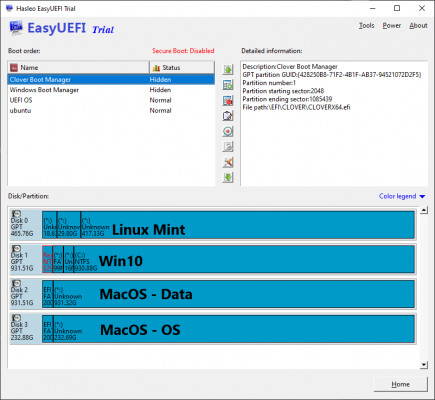06:00.0 Class 0604: Device 8086:15ea (rev 06)
Bus: primary=06, secondary=07, subordinate=f5, sec-latency=0
Capabilities: [c0] Express (v2) Upstream Port, MSI 00
LnkCap: Port #0, Speed 8GT/s, Width x4, ASPM L1, Latency L0 <64ns, L1 <2us
LnkSta: Speed 8GT/s, Width x4, TrErr- Train- SlotClk+ DLActive- BWMgmt- ABWMgmt-
LnkCtl2: Target Link Speed: 8GT/s, EnterCompliance- SpeedDis-, Selectable De-emphasis: -6dB
07:00.0 Class 0604: Device 8086:15ea (rev 06)
Bus: primary=07, secondary=09, subordinate=09, sec-latency=0
Capabilities: [c0] Express (v2) Downstream Port (Slot+), MSI 00
LnkCap: Port #0, Speed 2.5GT/s, Width x4, ASPM L1, Latency L0 <64ns, L1 <1us
LnkSta: Speed 2.5GT/s, Width x4, TrErr- Train- SlotClk+ DLActive- BWMgmt+ ABWMgmt-
LnkCtl2: Target Link Speed: 2.5GT/s, EnterCompliance- SpeedDis-, Selectable De-emphasis: -6dB
07:01.0 Class 0604: Device 8086:15ea (rev 06)
Bus: primary=07, secondary=7f, subordinate=82, sec-latency=0
Capabilities: [c0] Express (v2) Downstream Port (Slot+), MSI 00
LnkCap: Port #1, Speed 2.5GT/s, Width x4, ASPM L1, Latency L0 <64ns, L1 <1us
LnkSta: Speed 2.5GT/s, Width x4, TrErr- Train- SlotClk+ DLActive+ BWMgmt- ABWMgmt-
LnkCtl2: Target Link Speed: 2.5GT/s, EnterCompliance- SpeedDis-, Selectable De-emphasis: -6dB
07:02.0 Class 0604: Device 8086:15ea (rev 06)
Bus: primary=07, secondary=08, subordinate=08, sec-latency=0
Capabilities: [c0] Express (v2) Downstream Port (Slot+), MSI 00
LnkCap: Port #2, Speed 2.5GT/s, Width x4, ASPM L1, Latency L0 <64ns, L1 <1us
LnkSta: Speed 2.5GT/s, Width x4, TrErr- Train- SlotClk+ DLActive- BWMgmt+ ABWMgmt-
LnkCtl2: Target Link Speed: 2.5GT/s, EnterCompliance- SpeedDis-, Selectable De-emphasis: -6dB
07:04.0 Class 0604: Device 8086:15ea (rev 06)
Bus: primary=07, secondary=0a, subordinate=0a, sec-latency=0
Capabilities: [c0] Express (v2) Downstream Port (Slot+), MSI 00
LnkCap: Port #4, Speed 2.5GT/s, Width x4, ASPM L1, Latency L0 <64ns, L1 <1us
LnkSta: Speed 2.5GT/s, Width x4, TrErr- Train- SlotClk+ DLActive- BWMgmt- ABWMgmt-
LnkCtl2: Target Link Speed: 2.5GT/s, EnterCompliance- SpeedDis-, Selectable De-emphasis: -6dB
08:00.0 Class 0c03: Device 8086:15ec (rev 06) (prog-if 30)
Capabilities: [c0] Express (v2) Endpoint, MSI 00
LnkCap: Port #0, Speed 2.5GT/s, Width x4, ASPM L1, Latency L0 <64ns, L1 <1us
LnkSta: Speed 2.5GT/s, Width x4, TrErr- Train- SlotClk+ DLActive- BWMgmt- ABWMgmt-
LnkCtl2: Target Link Speed: 2.5GT/s, EnterCompliance- SpeedDis-, Selectable De-emphasis: -6dB
09:00.0 Class 0880: Device 8086:15eb (rev 06)
Capabilities: [c0] Express (v2) Endpoint, MSI 00
LnkCap: Port #0, Speed 2.5GT/s, Width x4, ASPM L1, Latency L0 <64ns, L1 <1us
LnkSta: Speed 2.5GT/s, Width x4, TrErr- Train- SlotClk+ DLActive- BWMgmt- ABWMgmt-
LnkCtl2: Target Link Speed: 2.5GT/s, EnterCompliance- SpeedDis-, Selectable De-emphasis: -6dB
7f:00.0 Class 0604: Device 8086:15c0 (rev 01)
Bus: primary=7f, secondary=80, subordinate=82, sec-latency=0
Capabilities: [c0] Express (v2) Upstream Port, MSI 00
LnkCap: Port #0, Speed 2.5GT/s, Width x4, ASPM L0s L1, Latency L0 <2us, L1 <4us
LnkSta: Speed 2.5GT/s, Width x4, TrErr- Train- SlotClk+ DLActive- BWMgmt- ABWMgmt-
LnkCtl2: Target Link Speed: 2.5GT/s, EnterCompliance- SpeedDis-, Selectable De-emphasis: -6dB
80:00.0 Class 0604: Device 8086:15c0 (rev 01)
Bus: primary=80, secondary=82, subordinate=82, sec-latency=0
Capabilities: [c0] Express (v2) Downstream Port (Slot+), MSI 00
LnkCap: Port #0, Speed 8GT/s, Width x1, ASPM L0s L1, Latency L0 <2us, L1 <4us
LnkSta: Speed 2.5GT/s, Width x1, TrErr- Train- SlotClk+ DLActive+ BWMgmt- ABWMgmt-
LnkCtl2: Target Link Speed: 8GT/s, EnterCompliance- SpeedDis-, Selectable De-emphasis: -3.5dB
80:01.0 Class 0604: Device 8086:15c0 (rev 01)
Bus: primary=80, secondary=81, subordinate=81, sec-latency=0
Capabilities: [c0] Express (v2) Downstream Port (Slot+), MSI 00
LnkCap: Port #1, Speed 8GT/s, Width x1, ASPM L0s L1, Latency L0 <2us, L1 <4us
LnkSta: Speed 2.5GT/s, Width x4, TrErr- Train- SlotClk+ DLActive- BWMgmt- ABWMgmt-
LnkCtl2: Target Link Speed: 8GT/s, EnterCompliance- SpeedDis-, Selectable De-emphasis: -3.5dB
82:00.0 Class 0401: Device 1c67:0104
Capabilities: [60] Express (v2) Endpoint, MSI 00
LnkCap: Port #0, Speed 2.5GT/s, Width x1, ASPM L0s, Latency L0 unlimited, L1 unlimited
LnkSta: Speed 2.5GT/s, Width x1, TrErr- Train- SlotClk+ DLActive- BWMgmt- ABWMgmt-
LnkCtl2: Target Link Speed: 2.5GT/s, EnterCompliance- SpeedDis-, Selectable De-emphasis: -6dB


